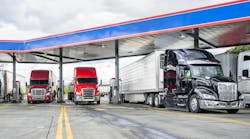Though the U.S. Environmental Protection Agency (EPA) has officially designated greenhouse gases (GHGs) a threat to the public health and welfare of the American people, and that GHG emissions from on-road vehicles contributes to that threat, the ultimate impact this will have on the trucking industry is unknown at this point.
“The release of the endangerment finding is seen as an effort to focus more attention on pending federal climate change legislation – but it does not include any proposed regulations,” noted Glen Kedzie, an American Trucking Assns. (ATA) vp, told FleetOwner. “[But] it’s unclear at this time how the EPA’s endangerment finding will affect the trucking industry.” (Read more news about the ATA)
In a speech yesterday, EPA Administrator Lisa P. Jackson said her agency’s endangerment final finding is a response to a 2007 U.S. Supreme Court decision that said GHGs fit within the Clean Air Act definition of air pollutants and covers six key gases – carbon dioxide, methane, nitrous oxide, hydrofluorocarbons, perfluorocarbons and sulfur hexafluoride.
“This endangerment finding provides the legal foundation for finalizing the recently proposed clean cars program, [which] contains the nation’s first ever limits on greenhouse gas emissions from American vehicles,” Jackson said. “And starting next spring, large emitting facilities will be required to incorporate the best available methods for controlling greenhouse gas emissions when they plan to construct or expand.”
Jackson stressed that, though the EPA’s findings do not in and of themselves impose any emission reduction requirements, they allow the agency to finalize the first-ever federal GHG tailpipe standards for new light-duty vehicles. Those were proposed on Sept. 15 as part of the joint rulemaking with the Department of Transportation (DOT). Those rules are expected to be finalized by March 2010.
“These are reasonable, common-sense steps that will allow us to do what the Clean Air Act does best: reduce emissions for better health, drive technology innovation for a better economy, and protect the environment for a better future,” Jackson said.
“On-road vehicles contribute more than 23% of total U.S. GHG emissions,” she added. “EPA’s proposed GHG standards for light-duty vehicles, a subset of on-road vehicles, would reduce GHG emissions by nearly 950 million metric tons and conserve 1.8-billion barrels of oil over the lifetime of model year 2012-2016 vehicles.“
Trucking is in indeed the EPA’s sights when it comes to controlling GHGs. ATA’s Kedzie noted that the agency is currently developing carbon metrics for trucking carbon outputs and that both the House and Senate climate change bills contain provisions for the agency to take the lead in establishing regulations to limit GHGs from medium- and heavy-duty trucks.
Yet the agency’s recent Final GHG Inventory Rule does not include reporting requirements for trucking fleets. That means the ultimate impact of EPA’s GHG reduction efforts on trucking operations remains to be seen. “There are no specifics known at this time as to what the finding may mean for the trucking industry,” Kedzie stressed.




